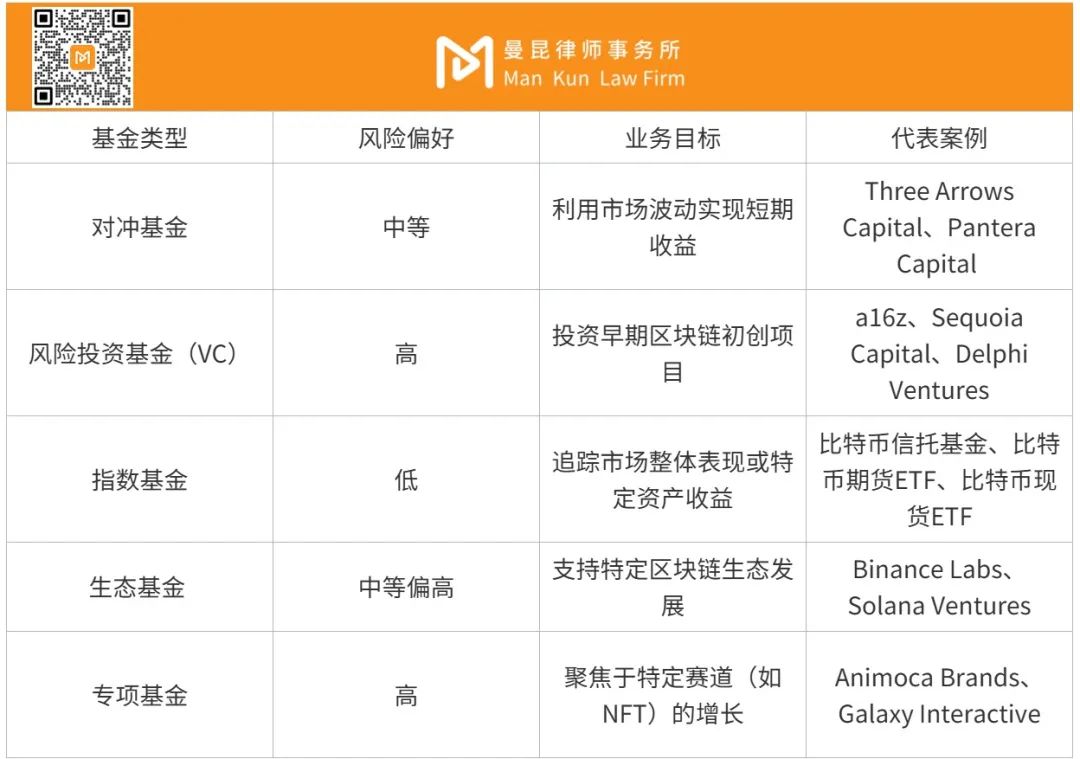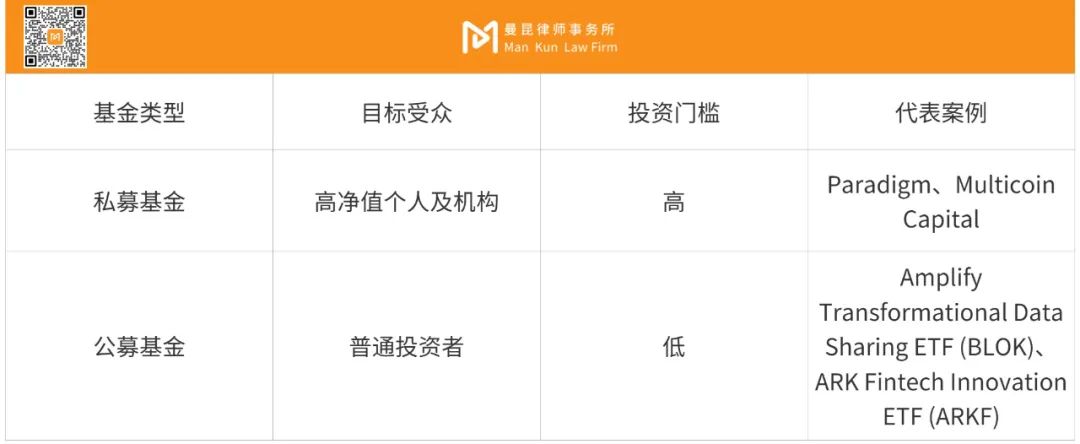Investment strategies are the core areas of cryptocurrency fund types, with each strategy corresponding to different investment goals and market logic.
Written by: Iris, Lawyer Liu Honglin
Currently, the types of cryptocurrency funds have continuously enriched with the evolution of market demand, from investment strategies to fundraising methods, and then to management methods and registration locations. The differences across various dimensions provide investors with diversified choices. These classifications not only reflect the innovative capacity of the crypto market but also offer suitable tools for investors with different risk preferences.
What types of Web3 investors are suitable for different cryptocurrency funds? What compliance considerations should different cryptocurrency funds take into account? In this article, Lawyer Mankun will answer these questions one by one, making it easier for everyone to choose based on their Web3 investment needs.
Classification by Investment Strategy
Investment strategies are the core areas of cryptocurrency fund types, with each strategy corresponding to different investment goals and market logic. From short-term arbitrage to long-term value mining, from robust and transparent index tools to specialized funds for cutting-edge asset allocation, these strategies collectively provide diverse choices for crypto investors.

Hedge Funds
Hedge funds achieve stable returns in the volatile cryptocurrency market through high-frequency trading, market arbitrage, and risk hedging strategies. Their flexible strategy design allows for operational space in both bull and bear markets. By capturing price differences across platforms and futures contract yields, hedge funds attract a large number of institutional investors and high-net-worth individuals.
Hedge funds typically choose to establish themselves in offshore regions (such as the Cayman Islands or Seychelles) due to the relatively loose regulation of private funds in these areas; if a hedge fund is established in the United States, it must comply with the relevant provisions of the Securities Act and the Commodity Exchange Act and register with the U.S. Securities and Exchange Commission (SEC). Additionally, the fund must strictly fulfill anti-money laundering (AML) and know your customer (KYC) obligations to ensure the transparency of fund sources and transactions.
Venture Capital Funds
Venture capital funds (VC) focus on supporting early-stage blockchain projects, providing high return potential for investors by investing in immature but high-potential technologies or ecosystems. Typically, venture capital funds not only provide financial support but also offer resource integration and strategic guidance to startups, accelerating the development of these projects. Similarly, venture capital funds are also suitable for institutional investors and high-net-worth individuals.
Establishing a venture capital fund requires clarifying whether the fundraising targets are qualified investors, especially in the U.S. and European markets, where laws require such cryptocurrency funds to raise funds only from high-net-worth individuals or institutional investors. Furthermore, if the investment project involves token issuance, it must ensure that the tokens comply with the securities laws of the target market. To meet compliance requirements, fund managers must be particularly cautious when designing token economic models to avoid illegal fundraising risks.
Index Funds
Index funds provide investors with simple and transparent investment tools by tracking market indices or specific asset performances. Their low-risk and high-transparency characteristics make them more suitable for traditional financial investors and ordinary investors who have not deeply engaged with Web3. Notably, the Bitcoin spot ETF approved in the U.S. in 2024 has attracted a large number of traditional financial investors. As of the time of writing, the total market value of Bitcoin spot ETFs has exceeded $100 billion.
The compliance of index funds highly depends on the regulatory environment of their registration location. For example, in the U.S., the approval of the BTC spot ETF means that fund managers must accept strict SEC regulation, including regular disclosure of the fund's investment portfolio and operational data. In other countries, the fund's compliance may also involve tax treatment and investor protection regulations.
Ecosystem Funds
Ecosystem funds aim to promote the development of blockchain networks and application scenarios, and thus are usually established by project teams themselves. They directly promote the increase in token value and network activity by investing in projects within specific ecosystems (such as dApps and infrastructure).
Establishing an ecosystem fund requires special attention to the token design and issuance compliance of the projects it invests in. Funds operating in multiple jurisdictions must meet the securities regulatory requirements of each location. For example, the EU's compliance review of ICOs focuses on information disclosure and investor protection, while Hong Kong requires funds to obtain relevant licenses from the SFC. Additionally, if the fund plans to expand its business through cross-border fundraising or trading, it must comply with anti-money laundering and tax reporting rules in various countries.
Specialized Funds
Specialized funds provide opportunities to capture high growth potential in specific asset classes or market sectors by focusing on them. Their characteristic lies in the concentrated allocation of resources, allowing for more effective exploration of market value in specific fields, such as NFTs, tokenized physical assets, or blockchain infrastructure. Specialized funds attract high-risk preference investors, including institutions and high-net-worth individuals, who wish to deeply participate in cutting-edge fields.
The establishment of specialized funds typically chooses regions like Singapore or the Cayman Islands, where the legal environment for innovative assets is relatively accommodating. However, fund managers must pay special attention to the legality of the target assets. For example, when investing in NFTs, it is necessary to ensure that the intellectual property rights are clearly defined; funds for tokenized physical assets must comply with the regulations of the target country regarding rights confirmation and token trading. Additionally, the operation of specialized funds must also comply with tax reporting, anti-money laundering (AML), and know your customer (KYC) requirements to ensure the transparency of funds and transactions.
Classification by Fundraising Method
The fundraising method of cryptocurrency funds is a key factor affecting their target audience, operational model, and compliance requirements. Based on the fundraising targets and regulatory frameworks, cryptocurrency funds can be divided into private funds and public funds.

Private Funds
The fundraising process for private funds is typically not public and has capital requirements, resulting in a higher investment threshold. However, private funds have more flexible investment strategies, allowing for rapid adjustments based on market dynamics, helping investors achieve high returns. However, the high-risk nature of these funds also means that investors need to have strong market awareness and risk tolerance.
Private funds usually choose to establish themselves in regions with relatively loose regulations, such as the Cayman Islands or Singapore. These areas have lower registration and disclosure requirements for private funds, providing flexibility for fund operations. If one wishes to establish a private fund in the U.S., it must submit Form D to the SEC, clarifying that the fund is only open to qualified investors. Additionally, private funds must fulfill anti-money laundering (AML) and know your customer (KYC) obligations to ensure the legality of fund sources.
Public Funds
Public funds lower the entry barrier for ordinary investors into the cryptocurrency market through public offerings. These funds typically adopt transparent investment strategies and must meet strict information disclosure requirements, including investment strategies, risk assessments, and regular investment portfolio reports. This makes them more suitable for investors with lower risk preferences who seek stable returns.
Public funds must comply with the strict regulatory rules of the target market. For example, in the U.S., public funds need to obtain SEC approval and comply with the Investment Company Act's requirements, including risk disclosure, investor protection, and operational transparency. Additionally, the managers of public funds must ensure compliance with tax reporting and fulfill anti-money laundering obligations.
Classification by Management Method
The management method of cryptocurrency funds is one of the important factors affecting investment strategies and returns.
Based on different management methods, cryptocurrency funds can be divided into actively managed funds and passively managed funds. The core difference between these two types of funds lies in the way investment decisions are made and the flexibility of management strategies.

Actively Managed Funds
Actively managed funds are overseen by experienced fund managers responsible for investment decisions, focusing on adjusting asset allocation to achieve higher returns through market trend analysis. For example, fund managers can increase holdings in strong-performing assets based on market movements or quickly reduce positions to avoid risks during market downturns. This flexibility allows actively managed funds to have stronger risk resistance and return potential amid market volatility.
Actively managed funds are suitable for investors with higher risk preferences, especially high-net-worth clients and institutional investors who wish to achieve excess returns through professional management. However, their higher management fees and more complex operational models also mean that fund managers need to possess strong market insight and adaptability.
Actively managed funds are typically recommended to be established in regions like the Cayman Islands or Singapore, where regulations on private funds are relatively loose. However, if established in stricter regulatory markets like the U.S., actively managed funds must submit investment strategy and risk disclosure documents to the SEC. Additionally, fund managers must comply with anti-money laundering (AML) and know your customer (KYC) regulations to ensure the legality of fund sources and mitigate compliance risks.
Passively Managed Funds
Passively managed funds achieve automated management of asset allocation by tracking market indices or using automated algorithms, thereby reducing the frequent intervention of fund managers and minimizing the risks of human decision-making. Compared to actively managed funds, passively managed funds have lower fees and higher transparency, making them more suitable for investors with lower risk preferences. In particular, ordinary investors who wish to reduce risk through diversified investments can enter the cryptocurrency market via passively managed funds and enjoy the returns brought by overall market growth.
The operation of passively managed funds relies on the legal framework of their registration location. For example, in the U.S., the approval of the BTC spot ETF signifies that passively managed funds must accept strict SEC regulation, including information disclosure and risk review. In other markets, such as Canada's Purpose Bitcoin ETF, funds need to regularly submit operational data to local securities regulators to ensure transparency and compliance. Additionally, the managers of passively managed funds must still fulfill anti-money laundering obligations and ensure the effective implementation of investor protection mechanisms.
Classification by Registration Location
The registration location and regulatory framework of cryptocurrency funds have a profound impact on their operational models and compliance. From offshore funds with favorable tax conditions to onshore funds under strict regulation, the policy environments of different regions provide unique support and constraints for funds. These choices not only affect the establishment costs and management flexibility of funds but also determine their credibility and attractiveness among investors.

Offshore Funds
Offshore funds refer to funds registered in foreign or offshore jurisdictions, often referred to as tax havens, such as the Cayman Islands, Seychelles, or the British Virgin Islands (BVI). These funds are designed for non-resident investors, allowing for rapid adjustments to investment portfolios through simplified legal frameworks to respond to market fluctuations and leverage advantages in cross-border arbitrage.
The lenient policies of the registration location provide convenience for fund managers but also come with lower transparency and governance risks. To gain the trust of investors, offshore fund managers need to establish clear governance mechanisms and regularly disclose operational information to enhance transparency. Additionally, cross-border investment and trading activities must pay special attention to the anti-tax avoidance regulations of the target markets to avoid potential legal risks.
The registration process for offshore funds is relatively simple. For example, in the Cayman Islands, a fund can start operating with basic registration, requiring only the hiring of a registered agent and the regular submission of financial reports. In Seychelles, the fund must complete the registration process and comply with the local Financial Services Authority's regulations, including minimum requirements for anti-money laundering (AML) and know your customer (KYC). Additionally, cross-border investment or trading activities must pay special attention to the anti-tax avoidance regulations of the target market to avoid legal risks.
Onshore Funds
Unlike offshore funds, onshore funds are registered in the investor's country or region and are subject to strict local regulations. The United States, Singapore, and Hong Kong are the main registration locations for such funds. Through comprehensive information disclosure and investor protection policies, onshore funds can attract a large amount of mainstream capital and institutional investors.
The core advantages of onshore funds lie in their transparency and stability. A strong legal system provides higher security guarantees for investors, while the high compliance of these funds makes it easier to obtain global capital support and policy endorsement. However, these advantages also come with higher establishment costs and operational requirements.
For instance, in Hong Kong, cryptocurrency fund managers must apply for a Type 9 regulated activity license under the Securities and Futures Ordinance (SFO) to engage in virtual asset fund or traditional asset management business. Additionally, the Hong Kong Securities and Futures Commission (SFC) has imposed stricter requirements on funds involving virtual assets, such as ensuring that the virtual asset trading platforms they invest in are recognized or regulated, and fulfilling information disclosure and risk management obligations to provide higher protection for investors.
Advice from Lawyer Mankun
The diversity of cryptocurrency funds offers Web3 investors a wealth of choices, but it also places higher demands on investors' judgment. In the actual establishment of cryptocurrency funds, Lawyer Mankun summarizes the following aspects to help everyone make judgments:
Clarify Investment Goals and Risk Tolerance
If you pursue short-term returns and can tolerate higher risks, hedge funds may be a suitable choice; if you are optimistic about the high growth potential of early blockchain projects, you might consider venture capital funds (VC); alternatively, for investors who prefer long-term stable returns, index funds are more attractive, especially low-risk tools like spot ETFs.
Pay Attention to the Legal and Tax Environment of the Registration Location
Offshore funds are suitable for investors seeking high flexibility and low tax costs, but it is essential to note whether the fund manager has good governance and transparency; onshore funds are more suitable for investors who prioritize transparency and legal protection, especially those looking to attract traditional financial capital or highly compliant institutions.
Additionally, it is recommended that investors consider the legal requirements of the target market, focusing on the registration location's regulations regarding information disclosure, licensing, anti-money laundering (AML), and tax reporting.
Evaluate the Professionalism and Historical Performance of the Fund Manager
The investment strategy and past performance of the fund manager are important references for judging the quality of the fund. Therefore, when choosing to participate, it is necessary to check the background of the fund management team, understand whether they have rich experience in the blockchain industry and financial management capabilities, and analyze the fund's past investment performance and project layout to ensure that the manager can achieve investment goals in a complex market environment.
免责声明:本文章仅代表作者个人观点,不代表本平台的立场和观点。本文章仅供信息分享,不构成对任何人的任何投资建议。用户与作者之间的任何争议,与本平台无关。如网页中刊载的文章或图片涉及侵权,请提供相关的权利证明和身份证明发送邮件到support@aicoin.com,本平台相关工作人员将会进行核查。




